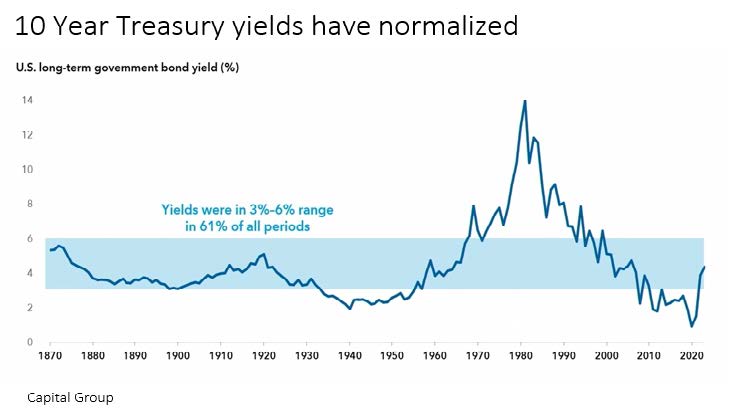There is much to consider when you are approaching retirement or perhaps already retired. We understand people can be overwhelmed with the many investment options. In this Investment Thoughts, we are taking a dive into the bond market to help you understand how bonds can benefit your investment portfolio.
Role of Bonds
Bonds are nothing more than a simple loan. Investors provide capital to issuers (the borrower). Issuers are contracted to make regular interest payments and return the capital at the bond maturity date. Bond maturities can range from 30-days to more than 30 years. Both the length to maturity and the credit worthiness of the issuer impacts the level of interest on the bonds.
Clients have heard us say many times that asset allocation is the primary determinant of portfolio returns and risk. Since 1926, long term U.S. Government bonds have returned 5.1% per year while Treasury Bills or cash returned 3.3%. Stocks, with twice the volatility of bonds, returned over 10% per year. Stocks can provide a lot of return to portfolios but require investors to stomach periods of poor performance. High quality bonds help mitigate risk and often act a shock absorber to portfolios during periods of equity market turbulence. As result, most investors choose to temper volatility by owning a combination of these assets.
Bonds play three roles in a portfolio: 1) income, 2) stability and 3) equity diversification. Depending on the type of bond, one of the roles is more prevalent than others. Corporate bonds and extended credit sectors offer higher yields as they trade with a credit spread premium to compensate an investor for the potential of default. Cash and bonds with shorter maturities exhibit less volatility as the shorter investment horizon removes uncertainty and provides stability. Finally, longer-term high-quality bonds provide diversification during recessions when stocks usually decline in value. This is because interest rates tend to fall in periods of economic weakness. Bond prices move inversely with yields and rise when rates are falling.
Bonds are Not Risk Free
Bonds do have some risks associated with them. Most bonds pay a fixed coupon interest payment until maturity. If inflation rises dramatically the coupon received in later years is worth less in terms of purchasing power. Corporate bonds can default on payments if the underlying issuer declares bankruptcy. Furthermore, the bond price can decline even if the perception of the default increases and the credit spread widens. Some bonds do not trade often and could be subject to illiquidity risk. Meaning if an investor needs to sell, the bond price offered maybe lower than expected if there is not a lot interest for the investment. This especially happens when bonds are traded at small sizes as larger investors might not be interested in small bond blocks.
Bond Sectors
U.S. Government bonds, corporate bonds, and securitized debt are the three main taxable bond sectors in the U.S. investment grade universe defined by the Bloomberg U.S. Aggregate Bond Index. U.S. Government debt comprise about 47% of the index, while U.S corporate debt is 25% and securitized debt is 28% of the index. Securitized debt is the least well known and most confusing sector. It is mostly mortgaged-backed securities comprised of pools of home mortgages issued by Fannie Mae and Freddie Mac. These issuers pool thousands of mortgages together into one security. As homeowners make their monthly mortgage payments, investors receive interest and principal payments from the pass-through investments.
In addition to investment grade, there are smaller riskier sectors (extended credit) including high yield and floating rate loans issued by corporations and emerging sovereign debt bonds. These types of bonds have significantly more risk of default on the payments owed to investors. To compensate investors for added risks, they pay much higher interest rates. Because these sectors are also more sensitive to the ups and downs of the economy, they provide less protection and diversification to a portfolio of stocks.
2022 Unlocked Opportunities in Bonds
A lot has changed in the bond market since the pandemic brought unprecedented monetary and fiscal stimulus causing inflation to surge to 9%. The Federal Reserve then raised short-term interest rates at the fastest pace in 40 years to 5.50%. This led to the worst bear market in history as bond prices fell sharply. Fortunately, we did not have a repeat of the 1980’s with extremely high inflation as the yield chart below indicates when interest rates peaked at 14%.
The yield chart below provides us a historical picture of a 3% to 6% yield being the norm and the end of chart, far right, shows currently 4.5%. So, not that far off the normal yield. However, the past decade (starting at 2010) of low interest rates made it very challenging for investors to earn the income they need. This was particularly challenging for retirees in need of income to assist with their cashflow. Those low rates became the reason bonds were termed “boring” resulting in many investors not wanting to include them in their asset allocation.

Today, the silver lining is interest rates have reset higher and inflation has come down. Higher bond yields mean that there is an opportunity to earn a higher return from bonds going forward. When the Federal Reserve cuts interest rates, which may happen later this year, both short- and long-term interest rates tend to fall together. Remember, when interest rates fall bond prices rise, and this allows bonds to be an attractive asset class, no longer “boring” but profitable. This is a big change from the past decade.
How do Bonds Compare to Cash?
Interest earned on cash and money market funds are all tied to the Federal Funds rate which is controlled by the Federal Reserve. When the Fed Reserve changes this rate, it influences a broader set of interest rates that impact all of us. Holding cash may be comforting and good options for building up your emergency savings. However, for the longer-term investor, the outlook for interest rates is important to your asset allocation and investing cash is part of that decision. Cash outperformed longer-term bonds while the Federal Reserve increased interest rates and it was great to finally get paid a nice income while holding cash. But holding too much cash can lead to an opportunity cost of forfeiting potential profits/returns. Currently, the yield curve is inverted, meaning that short-term interest rates are higher than yields of longer dated bonds. It is tempting to stay in cash until longer dated bonds yield more than cash rates. However, during a rate cut, cash tends to underperform longer-term bonds. This happens because long maturity dated bonds are more sensitive to interest rate movements and will experience a rise in bond prices, therefore creates appreciation in value.
Bond Funds Versus Individual Bonds
Clients sometimes ask if it is better to invest in individual bonds than to purchase bond funds. To some, it is comforting to see the individual bonds in an account as bond prices fall from rising interest rates. It easier to see that if the bond is held to maturity, the investor will receive their entire investment back at maturity, even though the same occurs with bonds held in a mutual fund. While individual bonds provide more control, bond funds have several advantages. First, they are significantly more diversified, holding hundreds or thousands of individual bonds. By spreading risk among a range of fixed-income securities, fund managers reduce the impact on a portfolio if any single bond defaults. Bond funds also benefit from scale. They can buy bonds at much lower prices than those that are buying smaller bond positions. They also often have access to bonds that are not available to smaller investors. Bond fund managers have tended to demonstrate a greater probability of outperforming their benchmark as a result of these advantages.
We believe bonds have become more attractive now that bond yields have reset higher and the “income” is back in fixed income. Bonds offer a more attractive income stream than they did over the last decade to assist with your cashflow needs and provide layer of stability to your portfolio. Please let us know if you would like to discuss how bonds fit into your personal asset allocation and help you meet your retirement goals.

Karen Crump
Senior Portfolio Manager
karen.crump@ledyard.bank

Thomas Hudson, CFA
Senior Portfolio Manager and Investment Strategist
thomas.hudson@ledyard.bank